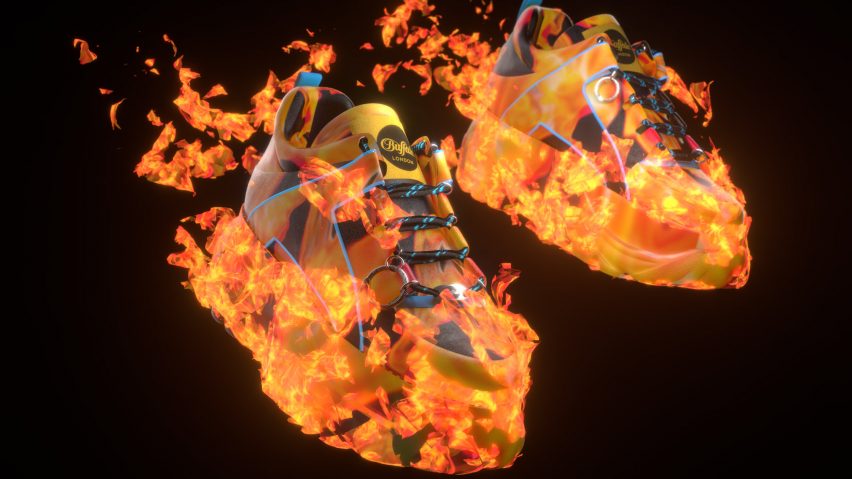Shoe brand Buffalo London has teamed up with digital fashion house The Fabricant to create a flaming virtual trainer that can only be "worn" in images for social media.
The design, dubbed the Classic BurningFor, is based on a 3D scan of the brand's Classic Low platform shoes, first popularised by the Spice Girls in the 90s.
Now in 2021, it's been updated for the age of the internet using CGI animation software to create a digital version lapped in blue or red flames.
Beyond being Buffalo London's debut digital-only product, the company claims this also marks the first time that an established brand has made a virtual wearable available for purchase on its website alongside its regular, physical products.
Last year, with the coronavirus pandemic limiting occasions to wear real clothes, interest in digital fashion skyrocketed and a slew of big-name brands created computer-generated versions of their garments.
However, these were generally made to be worn by gaming avatars and could be bought within the games themselves, as with the bright orange, branded backpacks and bucket hats that Gucci designed for The Sims 4 and the looks that Marc Jacobs and Valentino released on Animal Crossing.
The Classic BurningFor on the other hand is available via Buffalo London's own website, much like a real product, as well as through Dress-X – a multi-brand e-commerce retailer dedicated exclusively to digital fashion.
Shoppers simply supply a photo of themselves, in which they would like to wear the shoes, and Dress-X uses 3D software to "digitally dress" them and tailor the "fit" of the shoes to the chosen picture, which the owner can then share on their social media channels
"You could call it a sort of 3D photoshop, but it's way more complex as it takes the environment, lighting and all kinds of effects into account," The Fabricant co-founder Amber Jae Slooten told Dezeen.
"Unfortunately, the technology is not there yet for people to wear it in multiple images. However, we do think that this also makes people think about what image they use and more conscious about creating the image itself."
Only 100 pairs of the virtual trainers will be sold, at around €25 for a still image and double that for a moving video, in which the flames flicker and dance around the wearer's ankles.
Using fire as if it were a fabric shows off the nearly limitless possibilities of digital fashion as well as hoping to speak to the wider cultural zeitgeist.
"The idea was to create a concept that would acknowledge the hard times we're living in with this pandemic, but that also expresses optimism. Mythologically-speaking and in reality, fire is a force for transformation and has always been a symbol of rebirth," Slooten said.
"We thought that by using a material that resonated with people, but which could never exist in real life, we could create a sense of exploration and wonder that allows us to transcend our day-to-day reality."
"It is meant to be a conversation piece, not a fleeting image," she added.
The fashion industry is one of the most polluting in the world. It is responsible for 10 per cent of global carbon emissions – totalling more than all international air travel and maritime shipping combined – as well as guzzling up enough water a year to sustain five million people and producing 20 per of all wastewater worldwide.
And yet, almost three-fifths of all the clothing produced in the process ends up in incinerators or landfills within a year.
Slooten argues that digital fashion offers an alternative to this, which promotes individual experimentation and expression through clothes without the cost to the planet.
"We hope that slowly, brands will realise that a digital-only product is faster, more sustainable, cheaper and also more accessible. Imagine shipping a shoe halfway across the world to be worn, while you're also able to instantly download it and wear it wherever you like, whether on your digital avatar or your picture," she explained.
"In the future, we hope people will be able to wear digital items over their bodies using augmented and mixed reality technologies with lenses or glasses. It won't be long before we all walk around in virtual outfits that can change with the click of a button – like a face filter for your body."
Slooten founded The Fabricant alongside Kerry Murphy in 2018 and was the Amsterdam Fashion Institute's first-ever students to graduate with an entirely digital collection.
In a live panel discussion hosted by Dezeen as part of London Craft Week last year, she predicted that self-expression in the physical world will become more subdued due to environmental concerns associated with clothing production, but that virtual fashion will step in to fill the gap.
"Within the digital world, we can go completely crazy," she argued. "We can wear a dress made of water or have lights everywhere and change your textile according to your mood."

